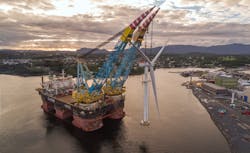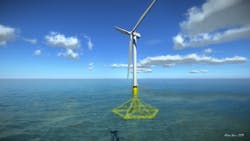Oil and gas engineering groups have had to redefine their roles in response to the rapid changes brought on by the energy transition. Saipem was among the earliest to anticipate developments, investing in emerging technologies for floating wind and wave energy, and more latterly floating solar power, hydrogen, and carbon capture.
One of the goals was to transfer Saipem’s long experience in managing turnkey contracts for oil and gas to low carbon and renewable energy projects.
Mauro Piasere, Head of Offshore New Energies Business Unit, explained: “At Saipem we have talked about the energy transition for a long time. This has always been about making use of natural gas and LNG to transit to a cleaner world: renewables represent the end of this transition, and this is where we want to be, developing and integrating different energy sources such as wind, wave, solar, tidal. A number of technologies are approaching Technology Readiness Level: we think we can develop these further to satisfy our clients’ needs, but this process is also about learning the language of developers, lenders, and the countries hosting the projects.”
Offshore wind currently represents 90% of the projects the company is executing in the offshore sector as a whole. These range from EPCI/EPC jobs calling for construction and installation of large numbers of jackets, monopiles or gravity base structures for the Neart Na Goithe and giant Dogger Bank projects in the UK North Sea and the Courseulles and Fécamp projects offshore northern France; to transport and installation of HVDC or HVAC and substations for Dogger Bank and Seagreen, also in the North Sea, and for the St-Brieuc wind farm off northwest France; to engineering of jackets for Formosa 2 off Taiwan. The flagship semisubmersible crane vessel Saipem 7000 is undertaking most of the offshore campaigns, supported recently by the DP heavy-lift vessel Saipem 3000. Although the crews draw on their experience from offshore construction, “there is a large difference between installing a platform for oil and gas, a structure that doesn’t move, and installing a jacket with a wind turbine that rotates,” Piasere said. “The complexity involved requires a higher skills level.”
Depending on future opportunities, the company may allocate further vessels from its offshore fleet to support wind facilities installations, with some traditionally dedicated to SURF work potentially drafted in to lay large export power cables. Saipem also has yards at Arbatax, Sardinia and Karimun, Indonesia that are capable of constructing heavy substations, including for the future wind power developments planned for oil and gas field clusters offshore the UK and Norway to help reduce their CO2 emissions.
The North Sea has provided most of Europe’s fixed offshore wind developments to date, although projects are starting to emerge in the Baltic Sea and the Adriatic Sea. Engineering requirements vary widely between the regions. “Conditions in the Adriatic Sea call for wind turbine blades that you will never see in the North Sea. The technology we have developed for the Adriatic is designed to help the blades cope with winds that are less strong, but with more regular contact throughout the year. However, while fixed installations will continue to dominate new offshore wind projects, I believe that floating wind will develop at a much faster speed, once the industry has resolved fatigue/vibration issues arising from the connection between the turbine blades and the seabed, via the moorings.”
Saipem worked with Equinor on the world’s first floating wind farm, Hywind Scotland, developing solutions for the Saipem 7000 to lift and install the fully-assembled 6-MW turbo-wind generators/floating substructures onto the seafloor. Earlier this year, Saipem expanded its capability in floating offshore wind through acquiring the floating wind business of Naval Energies, a Paris-based developer of a semisubmersible floating structure for wind turbines suited to deeper waters farther out at sea, in the range 60-120 m (197-394 ft). The concept features four columns connected by metal components, with stability ensured mainly via a ballasting system that allows part of the foundation to be immersed. Naval Energies also designs the associated anchoring system and cabling, and is a partner in the Groix & Belle-Île pilot project, 22 km (13.7 mi) offshore western France, which comprises three 9.5-MW wind turbines (supplied by MHI Vestas Offshore Wind) and three floating structures. The pilot is said to be 80% representative of conditions at the locations of future commercial French wind farms.
Floating foundation
Last November Saipem signed an agreement that allows Italy’s National Research Council (CNR) to test the company’s Hexafloat concept, a pendulum-type floating foundation for wind turbines. This is for an offshore renewable energies research project funded by the Ministry of Economic Development. The project scope includes development of numerical models, trials at the Istituto di Ingegneria del Mare’s (INM) indoor basin, and construction and installation of a relatively small prototype Hexafloat in a marine laboratory in Naples that can simulate conditions at sea. The program in Naples is currently under way, managed by CNR-INM and the Engineering Department of a local university. For Saipem, the main goals are to advance the floating foundation concept to Technology Readiness Level and to improve the design criteria in order to bring down the cost.
Hexafloat is a one-size-fits-all foundation, deployable with a wide range of turbines by means of its adjustable, hanging counterweight. It is also designed to be compatible with the new larger and much heavier 12-15-MW wind turbines planned at deeper-water and harsher environment locations, reducing the size of the giant floating structure that would otherwise be needed to accommodate these turbines. The company sees potential for the concept in future floating wind farms located in areas including offshore the US West Coast, the Mediterranean Sea, Norway, and Japan.
Another of Saipem’s drivers toward the energy transition has been the company’s XSIGHT division, established in late 2017 to serve as what was described at the time as an ‘efficiency accelerator’ for the energy industry, seeking to challenge and change the traditional sequential development of projects through digitalization and new design methodologies.
Piasere, who was tasked with building XSIGHT from scratch, assembled a group of engineers with EPCI experience. The services proposed covered all Saipem’s traditional activities, from front-end engineering to execution, the full spectrum from downstream to offshore floaters and subsea, and all types of renewable energies. “But we were also trying to be a bit more innovative,” he explained, “focusing on performance, not just on the delivered product, but also on its energy efficiency and carbon footprint…
“Being a start-up in the current financial climate has been quite a challenge. If you are not a recognized player, the value of our proposition is clear. Clients know of Saipem via its competence in EPCI, through its recent offshore projects such as Njord Future in Norway, Qatar’s North Field extension, ExxonMobil’s Blue Whale gas project in Vietnam [XSIGHT performed the full offshore/onshore FEED]. Having said that, the response from some renewable energy developers has been mixed. Some have been concerned that by committing to a company with EPCI capability, they will lose competitiveness once the development reaches the ready-to-build stage. But through knowing the language of banks, and how to make a project fly in terms of energy costs, we can offer EPCI value that is aligned to the developer’s need for a return on investment or which ensures delivery at a specific price.”
He cited as an example Saipem’s current co-development with Italian renewable energy specialist AGNES and QINT’X of the 450-MW Agnes wind farm in the northern Adriatic Sea, offshore Ravenna, which involves installing more than 50 turbines at two different sites. The project will also deploy floating solar technology developed by Moss Maritime, part of XSIGHT. “Because of the support from the project partners, the speed at which the development process is proceeding is very good for Italy. Another example is Saipem’s MoU with Plambeck Emirates to develop a 500-MW floating offshore wind project in Saudi Arabia.”
Moss Maritime has been working on a new floating solar park concept to capitalize on the potential for up to 400 GW of floating solar capacity globally, as estimated by the World Bank. It has also entered a collaboration agreement with Equinor to develop, test, and industrialize a floating photovoltaic system for harsh environments. This is a modular concept, devised to facilitate manufacture, transport, and install components in hard-to-access regions, and capable of withstanding strong winds and waves. The standard floating modules, each with a capacity of 24 MW, can be combined to form islands of varying sizes, depending on the local power needs.
The floating solar venture with Equinor is intended to be a fast-track development, and likely to be tested in the near future in real wave and current conditions in a fjord in Norway. “We think our design is pretty solid: we also want to develop it to be easy to produce, transport, and install. Our initial goal is to prove the system in up to 4-m [2.5-ft] significant wave heights. Saipem also sees scope to incorporate the technology into hybrid projects combining a floating photovoltaic solar park with a conventional oil or gas-powered plant, or integrated with marine wind farms.” Another possibility, according to Piasere, could be to install a small floating solar structure on an offshore platform for production and storage of green hydrogen.





